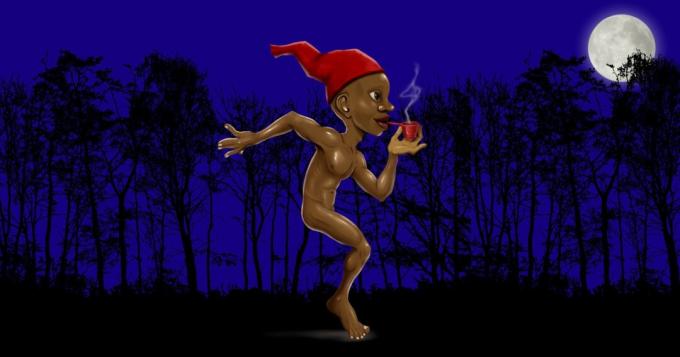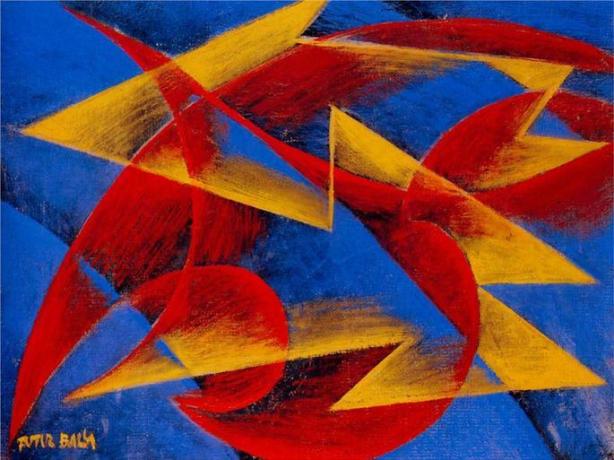The Saci-Pererê, or simply Saci, is one of the magical and legendary beings better known than Brazilian folklore. He is usually portrayed as a young black man with one leg, a prankster with a red cap, pierced hands and a pipe in his mouth.
During the 20th century, it became popular character of Brazilian culture, appearing in books, comics, series and films.

The Legend of Saci-Pererê
The legend of Saci-Pererê has several versions, varying according to location and time. The most famous version was the one popularized by the writer Monteiro Lobato in the book The Saci, from 1921.
the creator of Yellow Woodpecker Site describes him, through the character Uncle Barnabé, as a tiny being, endowed with magical powers, used to make mischief:
The saci is a one-legged devil that roams the world, setting up reigns of all sorts [...] It sours the milk, breaks the tips of the needles, hides the little nail scissors, tangles balls of thread, makes seamstresses' thimbles fall into holes, puts flies in the soup, burns beans in the fire, eats eggs of the litters. [...] Everything bad that happens in a house is always the art of saci. Not content with that, he also torments dogs, tramples chickens and chases horses into the pasture, sucking their blood. The saci does not do great evil, but there is no small evil that he does not do.
Son of a sorceress, Saci was born on a full moon night. To protect yourself from him, legend has it that you need to throw a sieve on the ground or put a seven-knot rosary around your neck: he is obliged to stop and undo all the knots.
Saci can turn into a whirlwind and disappear into thin air. According to legend, these magical powers emanate from his cap. Monteiro Lobato even indicates that whoever captured the shell would have powers over the devilish boy from the Brazilian forests.
In other versions of the legend, especially those found in northern Brazil, the Saci-Pererê has attributions quite different from those already mentioned. These characteristics are confused with those of other magical and legendary beings, such as the Curupira, the Caipora and the Matita Perê.
In these versions, for example, the Saci turns into a nocturnal bird, which haunts and bewilders travelers with its terrifying whistle.
Despite his antics, Saci is a much-loved figure in folklore. With its inventive and mischievous spirit, it arouses more sympathy than fear. His black identity makes him a positive national symbol, helping to dilute the prejudice that, unfortunately, we have not yet managed to eliminate from the country.
Origin
"Saci-Pererê" is a word of tupi origin. "Saci" comes from sa'si, name of a bird, and "pererê", from pererek, whose meaning is "to jump, bouncing".
There are several versions about how the legend came about. One version says that the character was created by the indigenous peoples who inhabited Brazil before the arrival of the Portuguese. Another version claims that Saci-Pererê is a mixture of elements from African culture, brought by slaves, and European customs.
A third version, widely accepted today, points to an indigenous origin of the Saci, which with time and the spread of the legend throughout the national territory has been changing, encompassing elements both from other original cultures, as well as from African and European ones. In this sense, the legend would reflect the characteristic heterogeneity of the formation of the Brazilian people.
The thesis of Saci's indigenous origin is reinforced by the presence of similar legends in the culture of peoples from countries bordering Brazil. In Paraguay, Argentina and Uruguay, for example, the Guarani speak of Yasi Tere (or Yasy-Ateré). It would be a kind of dwarf, who misleads travelers, kidnaps children and girls and has a magic wand or staff.
The legend of Saci, then, would have emerged among peoples originating in the southern region and, from the 19th century onwards, spread to the rest of the country. In this expansion, it would have gained other characteristics, such as, for example, the red cap (European influence), the absence of a leg and the black color (African heritage).
Adaptations of the Legend of Saci
Since the 20th century, Saci has become a famous and beloved character in Brazilian culture. This success is largely due to the adaptations of the legend to various contemporary media, such as literature, cinema, television series and comic books.
Literature
The first writer to study the legend, as we saw earlier, was Monteiro Lobato, author of the book The Saci, from 1921. However, this book is the result of a previous project by Emília's creator, carried out in 1917.
This is a research carried out by the author among the readers of the newspaper The state of Sao Paulo entitled "Brazilian Mythology — Inquiry on Saci-Pererê". The result of this research was published in a book (Lobato's first) the following year, with the title The Saci-Pererê: result of an inquiry.
Movie theater
The character's first screen appearance was in The Saci (1953), Brazilian film by Rodolfo Nanni and Nelson Pereira dos Santos. As can be seen from the title, it is a film adaptation of the homonymous novel by Monteiro Lobato.
Series
Saci debuted on Brazilian television in 1977 with the series Yellow Woodpecker Site, produced by TV Globo in partnership with TVE and the Ministry of Education and Culture. The series is an adaptation of Monteiro Lobato's children's novels. It was reissued in 2001.
Recently, Saci was a character in the series Invisible City (2021), directed by Carlos Saldanha and produced by Netflix. The series presents a police-esque plot involving entities from Brazilian folklore, such as Saci, Boto-cor-de-rosa, Cuca, Curupira and Iara.
Comics
In 1958, cartoonist Ziraldo produced the first comic strip about Saci, Pererê's gang, originally published in O Cruzeiro Magazine, and later in several publications.
Saci is also present in several stories of Monica's Gang, by Maurício de Sousa.
Saci's Day
Saci Day, celebrated on October 31, is a celebration of Brazilian culture and folklore, which takes place on the same date as the halloween is celebrated in several countries.
This date was created in 2003 by the social project "Saci no Bosque", carried out by the University of São Paulo (USP), aiming to honor one of the most popular figures in Brazilian folklore.
In 2005, Saci Day was instituted in São Paulo. Since then, it has been made official in several Brazilian cities and states.
During Saci Day, several activities are carried out to celebrate Brazilian culture and national folklore. In addition, environmental awareness activities such as tree planting and garbage collection.
This celebration represents an alternative to the halloween, a party that is not part of the Brazilian tradition, but which has been gaining popularity in the country in recent years.
Bibliography:
- LOBATO, Monteiro. The Saci. São Paulo: Brasiliense, 1994.
- CASCUDO, Luís da Câmara. Dictionary of Brazilian Folklore. So Paulo: Global, 2000.
- MEGALE, Nilza B. Brazilian folklore. Petropolis: Voices, 1999.
Know more:
- What is Folklore
- Brazilian folklore
- Characters of Brazilian Folklore
- curupira
- What is a Legend



